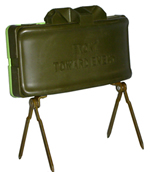M5 crowd control munition


The M5 modular crowd control munition (MCCM) is a
non-lethal direct fire device used to disperse, incapacitate and deny area access to large groups of people with percussion and flash (flash-bang) along with the impact from 600 high-velocity rubber or plastic balls moving outwards towards the crowd. It can be deployed and set up by troops (mounted or dismounted) and detonated via a command wire.[1]
It is similar in use and design to the
area denial, standoff situations, crowd control (i.e. outside embassies) by law enforcement and military services, the MCCM is effective to around 30 meters covering a 60–to-80 degree horizontal arc, with a minimum safe standoff distance of five meters from the face of the device.[2]
The MCCM is deployed in a minimum force role, where lethal outcomes may not be desired. It is a low hazard munition consisting of a 0.04" layer of sheet explosive (propellant). On one side of the sheet lies the projectiles (of .32 caliber, rubber or plastic
PVC material) and on the other side, a foam sheet. These components are held together by an inert binder similar to plasticine.[2]
As described above, the MCCM is very similar to the
M18A1 Claymore mine, except that the MCCM has a molded, tactile surface of raised diamonds on its back plastic cover which is a different color (light green), for easier discrimination between a lethal M18A1 Claymore and the non-lethal MCCM.[1]
886th Expeditionary Security Forces Squadron
's quick response force.It is currently in use by
US military
forces for area protection and defense. It can be vehicle mounted (for vehicle protection, and show-of-force crowd control), mounted to buildings and fencing, or used as a standalone device.
References
- ^ a b M5 Modular Crowd Control Munition. Globalsecurity.org.
- ^ a b M5 Modular Crowd Control Munition (MCCM). Pica.army.mil.
